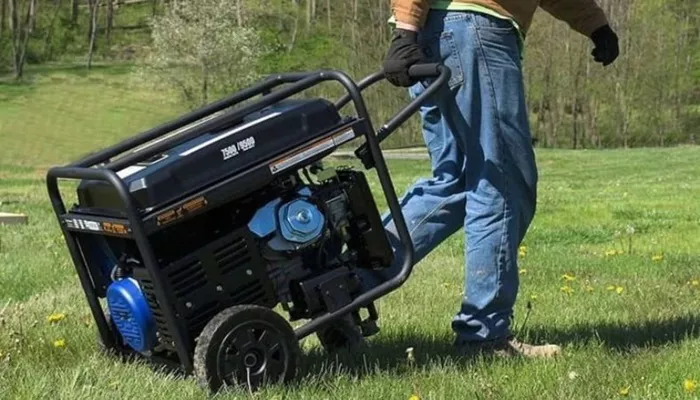In today’s world, having a reliable power source during outages or emergencies is essential. A 10,000-watt generator is a versatile solution for many households and small businesses. But what exactly can such a generator power? Understanding the capabilities of a 10,000-watt generator is crucial for homeowners looking to maintain comfort and functionality when the grid goes down. This article delves into the types of appliances and systems that can be operated by a 10,000-watt generator, helping you make informed decisions about your power needs.
Understanding Generator Power Ratings
The Basics of Power Measurement
Generators are rated by their power output, which is typically measured in watts. A 10,000-watt generator can provide 10,000 watts of continuous power, which can support various household appliances and systems. It’s essential to differentiate between starting and running watts when considering what a generator can run.
- Running Watts: This is the power needed to keep an appliance running continuously.
- Starting Watts: Many appliances require a higher amount of power to start than they do to run. This initial surge can sometimes double or triple the running wattage.
For example, while a refrigerator may need 700 watts to operate, it may require up to 1,200 watts to start. Understanding these two measurements is critical for efficient generator use.
Load Calculation
To determine what a 10,000-watt generator can power, you must calculate the total wattage of the appliances you intend to use. This includes both running and starting watts.
- List Appliances: Start by listing all the appliances you want to run simultaneously.
- Check Wattage Ratings: Look for the wattage ratings on the appliances or consult the user manual.
- Sum the Watts: Add the running wattages and the additional starting wattages for those that will be used simultaneously.
This calculation will provide a clear picture of your power needs and help you ensure that your generator can handle the load.
Appliances a 10,000 Watt Generator Can Run
Essential Household Appliances
A 10,000-watt generator can run several essential household appliances, making it suitable for emergency situations.
- Refrigerator: Most standard refrigerators require about 700 to 1,200 watts to run. This means a 10,000-watt generator can easily keep your refrigerator operational during an outage.
- Freezer: Similar to refrigerators, chest freezers typically require around 700 to 1,200 watts, making them manageable alongside other appliances.
- Air Conditioning Units: A 10,000-watt generator can support smaller air conditioning units (up to 2 tons) that require between 2,000 to 4,000 watts to start and 1,000 to 2,500 watts to run, but you need to be cautious of the starting wattage.
- Heating Systems: Electric heating systems, such as space heaters, can typically require between 1,500 to 2,500 watts. A 10,000-watt generator can run one or two space heaters simultaneously.
Kitchen Appliances
The kitchen is another area where a 10,000-watt generator can provide significant support.
- Microwave Oven: A typical microwave requires about 800 to 1,200 watts. Thus, you can use this alongside other kitchen devices.
- Coffee Maker: Standard coffee makers consume about 600 watts, allowing for multiple kitchen appliances to run simultaneously without overloading the generator.
- Electric Stove: Electric stoves can require up to 3,000 watts, so using one at a time along with smaller appliances is advisable.
Electronics and Lighting
In today’s homes, electronics are crucial for daily activities and entertainment.
- Televisions: Most modern LED TVs require between 100 to 400 watts, depending on the size.
- Computers: A desktop computer typically uses about 200 to 400 watts, while laptops use much less, around 50 to 100 watts.
- Lighting: LED lights consume about 10 to 20 watts per bulb, allowing you to run multiple lights on a 10,000-watt generator without significant strain.
Water Systems
Water systems are vital in many homes, especially in areas reliant on well water.
- Well Pumps: A 1 HP well pump typically requires around 1,200 watts to run and can surge up to 2,000 watts when starting. A 10,000-watt generator can run a well pump, making it a suitable choice for homes dependent on well water.
- Sump Pumps: Most sump pumps require between 500 to 1,200 watts, making them manageable for a 10,000-watt generator.
Limitations of a 10,000 Watt Generator
Powering Large Appliances
While a 10,000-watt generator is versatile, it may struggle to power multiple high-wattage appliances simultaneously. For example, running a central air conditioning unit and an electric stove at the same time could exceed the generator’s capacity, leading to overloads.
Surge Capacity Considerations
It is essential to understand that while the generator is rated for 10,000 watts, the surge capacity (the ability to handle starting watts) may not support multiple high-demand appliances starting at once. Therefore, careful planning is required to avoid exceeding the generator’s capabilities.
Tips for Efficient Generator Use
Prioritize Essential Appliances
In an emergency, prioritize running essential appliances first. This includes your refrigerator, heating or cooling systems, and any necessary medical devices.
Manage Your Load
To avoid overloading the generator, run appliances one at a time whenever possible. If you need to use high-wattage appliances, do so sequentially rather than simultaneously.
Use Watt Meters
Invest in a watt meter to monitor your appliance’s power consumption. This tool helps you track real-time usage and avoid unexpected overloads.
see also: What Size Diesel Generator Would You Need to Run a House?
Related topics:
- When Is the Best Time of the Year to Buy a Diesel Generator?
- How to Repair Diesel Generator?
- How to Turn a Diesel Engine into a Generator?

